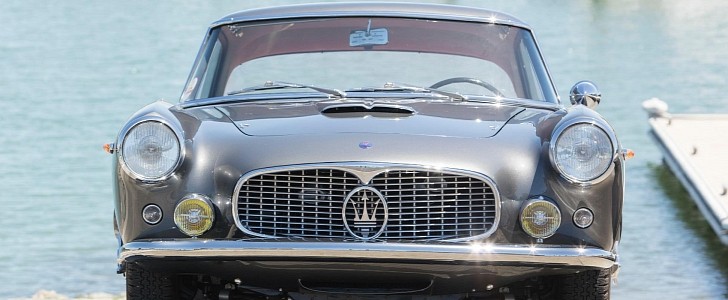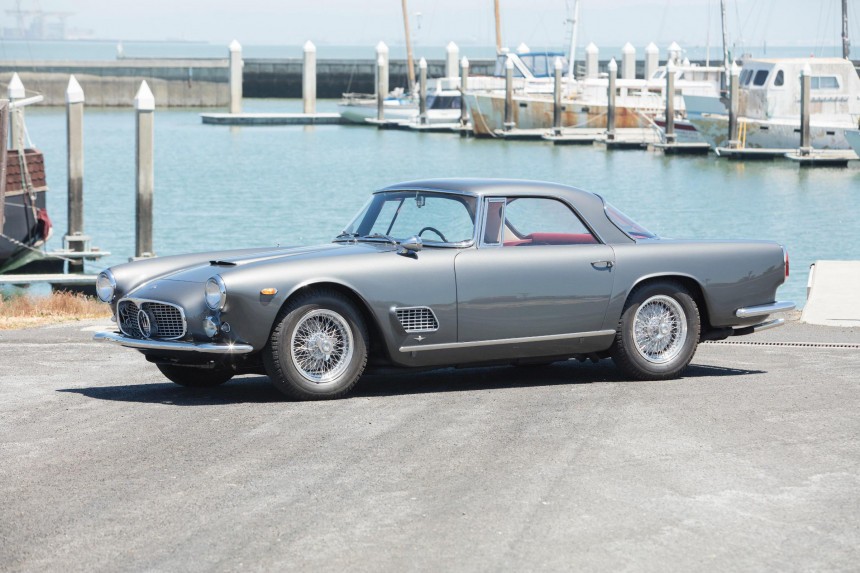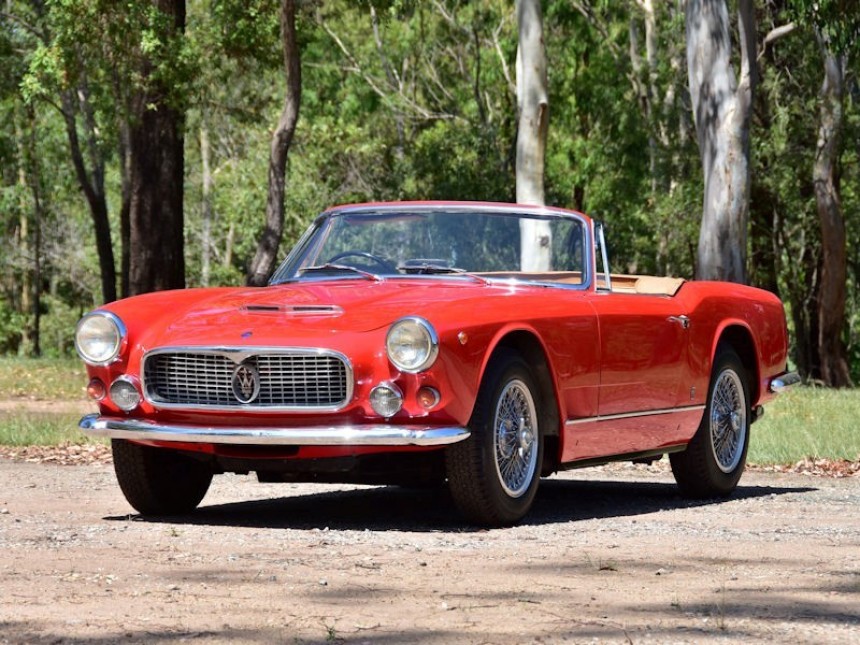The Maserati brothers developed the House of the Trident’s first-ever car in 1926, a Grand Prix racer dubbed Tipo 26. Two decades later, the A6 series rolled out as the Italian company’s first road-going production automobile. Come 1957, the automaker premiered the mass-produced 3500 series that paved the way for subsequent GTs and sedans.
Developed by chief engineer Giulio Alfieri, the 3500 GT used OEM components from a plethora of suppliers because money was tight. Italian firms Weber, Marelli, and Borrani were responsible for the carburetors, ignition system, and wheels. Zahnradfabrik Friedrichshafen, now ZF Friedrichshafen, supplied the four-speed manual of the GT and five-speed box of the fuel-injected GTi.
Over in England, the peeps at Salisbury were tasked with making the rear axle. Girling supplied the brakes, Alford & Alder were responsible for suspension componentry, and Borg & Beck made the clutch. Based on a tubular ladder frame featuring a 2,600-mm wheelbase, the GT is rocking independent front suspension with coil-sprung double wishbones and semi-elliptical leaf springs with a longitudinal torque arm out back. Both ends boast telescopic shocks, anti-roll bars, and hydraulic finned drum brakes.
Front discs were offered in 1959 as an option, the year optional wired wheels joined the standard light alloy wheels. Customers were further treated to a limited-slip differential. Come 1960 when Maserati previewed the 3500 GTi, the company made the front disc brakes and differential standard.
Originally mounted with Pirelli Cinturato, the 3500 GT takes its name from a DOHC straight-six engine that displaces 3.5 liters. Fed from an 80-liter fuel tank, the six-cylinder lump is an all-alloy design with hemispherical combustion chambers. Given that Chrysler released the first-gen HEMI in 1950 for model year 1951, Giulio Alfieri surely was on top of his game.
Derived from the 350 S straight-six mill, this powerplant dons two distributors, twin spark plugs, a seven-bearing crankshaft, as well as domed pistons. From a compression ratio of 8.2:1 versus 9.8:1 in the 350 S, the 3500 GT belts out 217 horsepower and a fair amount of torque while the 3500 GTi levels up to 232 ponies. For reference, the 5.4-liter FirePower HEMI V8 in the 1951 Chrysler New Yorker was originally rated at 180 ponies.
From the standpoint of design, the Touring Superleggera aluminum bodywork fits the grand tourer’s character just nicely. The gracious lines of the exterior are complemented by full-width chrome bumpers, a chromed trident logo in the center of the front grille, and a rather sexy hood scoop.
The rear fenders bring the point home with a finned theme and chrome strips that run from the rear window to the taillamps. Opening the driver’s door reveals fine leather upholstery on all four seats, Jaeger instrumentation that includes a 250-kph (155-mph) speedo, an ashtray next to the gear lever, vinyl for the top of the dash, and a grab handle for the front passenger. Great-looking quilted vinyl was originally used for the trunk. In terms of standard equipment, highlights include a radio and two electric windows.
Capable of hitting 100 kilometers per hour (62 miles per hour) in roughly 7.5 seconds, the 3500 GT tips the scales at 1,300 kilograms (2,866 pounds; dry weight). This model inspired Ferrari to introduce its first 2+2 grand tourer, the 250 GTE, in 1959. Including the fuel-injected GTi, all other body styles, and prototypes, the 3500 series outsold the Fezza to the tune of 2,226 examples of the breed versus 954 units for the Prancing Horse of Maranello.
Unveiled at the Turin Motor Show in 1958, the Vignale-bodied Spyder rides on a shorter wheelbase (2,500 millimeters). In addition to Touring and Vignale, coachbuilders that had a go at the 3500 series include Bertone, Frua, and lesser-known firms like Carrozzeria Allemano, Boneschi, and Moretti.
Zagato, which soldiers on as the only independent Italian coachbuilder, proposed a 3500 GT-based design in 1957. Even though sales brochures were printed, no bodies were produced by the Terrazzano-based outfit.
Over in England, the peeps at Salisbury were tasked with making the rear axle. Girling supplied the brakes, Alford & Alder were responsible for suspension componentry, and Borg & Beck made the clutch. Based on a tubular ladder frame featuring a 2,600-mm wheelbase, the GT is rocking independent front suspension with coil-sprung double wishbones and semi-elliptical leaf springs with a longitudinal torque arm out back. Both ends boast telescopic shocks, anti-roll bars, and hydraulic finned drum brakes.
Front discs were offered in 1959 as an option, the year optional wired wheels joined the standard light alloy wheels. Customers were further treated to a limited-slip differential. Come 1960 when Maserati previewed the 3500 GTi, the company made the front disc brakes and differential standard.
Derived from the 350 S straight-six mill, this powerplant dons two distributors, twin spark plugs, a seven-bearing crankshaft, as well as domed pistons. From a compression ratio of 8.2:1 versus 9.8:1 in the 350 S, the 3500 GT belts out 217 horsepower and a fair amount of torque while the 3500 GTi levels up to 232 ponies. For reference, the 5.4-liter FirePower HEMI V8 in the 1951 Chrysler New Yorker was originally rated at 180 ponies.
From the standpoint of design, the Touring Superleggera aluminum bodywork fits the grand tourer’s character just nicely. The gracious lines of the exterior are complemented by full-width chrome bumpers, a chromed trident logo in the center of the front grille, and a rather sexy hood scoop.
The rear fenders bring the point home with a finned theme and chrome strips that run from the rear window to the taillamps. Opening the driver’s door reveals fine leather upholstery on all four seats, Jaeger instrumentation that includes a 250-kph (155-mph) speedo, an ashtray next to the gear lever, vinyl for the top of the dash, and a grab handle for the front passenger. Great-looking quilted vinyl was originally used for the trunk. In terms of standard equipment, highlights include a radio and two electric windows.
Unveiled at the Turin Motor Show in 1958, the Vignale-bodied Spyder rides on a shorter wheelbase (2,500 millimeters). In addition to Touring and Vignale, coachbuilders that had a go at the 3500 series include Bertone, Frua, and lesser-known firms like Carrozzeria Allemano, Boneschi, and Moretti.
Zagato, which soldiers on as the only independent Italian coachbuilder, proposed a 3500 GT-based design in 1957. Even though sales brochures were printed, no bodies were produced by the Terrazzano-based outfit.


































































